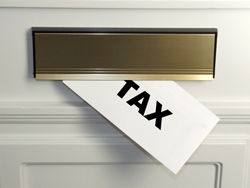The new French tax budget for 2013 explained!
Most of the measures decided for the 2013 budget are related to high income generated in France, which explain mainly why the new politic of Francois Hollande will not affect non residents.
The income tax will bring 72.6 billion Euros to the French state, representing half of the VAT, a 23% increase compared to 2012!
Rather than changing indirect taxes (VAT or CSG), the hardening of compulsory taxes will essentially rely on direct taxation, that the PS wants to make “more progressive”, so more severe for the wealthiest households.
It does not mean that every household will see its IR climb 23%, the growth of revenues coming from this tax is due to the reinstatement of many income scales, such as capital.
Similarly, the creation of a new tax bracket of 45% and a 75% windfall tax for high earners complete the income tax.
→ These are the main tax provisions affecting households in 2013
• Freeze of the French income tax scale
For the 2012 incomes, imposed in 2013. The government continues a team Fillon measure, by freezing the income tax scale (IR). A freeze which correspond to a 2% tax increase. However, this increase will only concern 16 million over the 36 million of French tax households. Due to a technical mechanism (the discount), the untaxed households and those taxed at 5.5%, so 20 million of households will see the freezing effects canceled. This new freeze will contribute to additional revenue of 1.3 billion to the state.
• “Quotient Familial”
The maximum benefit obtained by applying the familial quotient will increase from 2 336 to 2 000 Euros for each half share of family responsibilities, and revenues from 2012. According Bercy, a household with two children, will have to report more than 77,193 Euros of income per year to be impacted by this measure. Gain for the state: 490 million.
• A 45% Tax bracket
For 2012 income, imposed in 2013, the IR scale will include an additional tax backet, fixed at 45% for annual incomes above 150,000 Euros per unit. This measure, which will affect 50,000 taxpayers will earn 320 million to the state.
• Tax Breaks
For income taxes for 2013, paid in 2014, a household will not be able to reduce their bill of more than 10,000 Euros with tax breaks. Currently, the overall limit is €18,000, up to 4% of revenues. Concerning the loopholes taxes overseas, the Malraux (restoration of building frame) and Sofica (investment in film and broadcasting) will be released, however, from this overall limit.
• Alignment of capital taxation on labor taxation
This is the measure that will bring the most income: 3 billions. Currently, interests can be taxed at 24%, dividends at 21% and capital gains from the sale of securities (shares, bonds …) to 19%. For interest and dividend income in 2012 and disposals made on or after January 1st, 2012, the tax will be based on the scale of the IR (with one exception: The interests below 2000 Euros). This alignment of capital taxation on the labor will lighten the imposed tax on households with a 5.5% and 14% IR and will weigh down those taxed at 30%, 41% and 45%.
• 75% Tax
75% tax will apply during two years to any person who has earned an income in 2012 and 2013, exceeding 1 million. Capital income (capital gains, stock options, dividends …) will be exempt. In addition, the 75% tax, which will only concerned the fraction greater than 1 million, it will integrate the Fillon surcharge and social security contributions, so that the actual tax will be 63% or 64%. 1500 people will pay this tax, which will increase their tax to 140,000 Euros on average. The State will gain 210 million per year.
• Real Estate
From 2013, a new device for rental investment in suburbs with low income, the “Duflot,” will provide a tax cut, spread over nine years and equal to 18% of the purchase price of housing. If the tax refund is actually better than the current Scellier Law, however, the rent limit will be lower. Cost of this new niche: 35 millions.
• ISF (Wealth tax)
A new scale of ISF will be introduced in 2013, with tax rates ranging from 0.5% to 1.5%. The new scale will be more advantageous than the one which prevailed before the Sarkozy reform in 2011. The entry threshold to the ISF remains at 1.31 million Euros of
assets, and a mechanism will smooth out the input tax. A limit was reintroduced, the sum of the ISF, the income tax, social charges and the 75% tax shall not exceed 75% of the taxpayer’s income. In total, the redesign of the ISF will bring $ 1 billion of income in 2013.
• Solidarity Autonomy Contribution for retires
An employer contribution on wages, the CSA, was established in 2004, to finance aid to dependent elderly. Taxable pensions of retirees will also be subject to a reduced rate of 0.15%, against 0.3% of wages. This measure will fund social security spending, before being allocated in 2014, to the Dependency Reform, said the Minister for Senior Citizens, Michèle Delaunay.
• Automobile Bonus-malus
In accordance with the government’s commitment during the Environmental Conference, the penalty for polluting cars is reinforced. The threshold is lowered to 5g of CO2/km. In return, the bonus is increased from 5 000 to 7000 Euros for electric vehicles and from 2000 to 4000 Euros for hybrids. In total, the government plans to raise 400 million Euros with this penalty, but to spend $ 450 million for the bonus. The balance would be $ 50 million deficit. But the final figure will depend on the actual sales of cars in 2013.
• Increased contributions for auto entrepreneurs
The social security contribution of auto entrepreneurs is aligned with that of other individual entrepreneurs. This measure might be the end of the auto entrepreneurs’ treatment.


